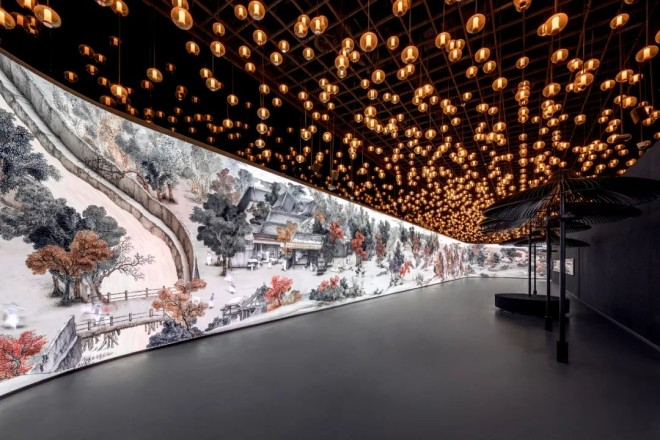序章
目次
1. What are the benefits of using LED display screens at exhibitions?
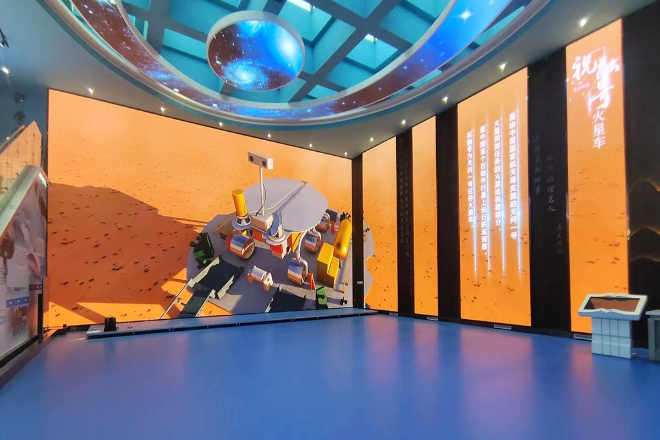
At exhibitions, LED display screens are like “big stars” and are particularly attractive. They are bright and colourful, and can clearly display content no matter how bright the surroundings are.
Now, almost every booth has an LED screen, and the competition is fierce, but as long as your content is exciting enough and the interaction is interesting enough, you can stand out.
For example, set up interactive games to make the audience have fun, and naturally, they are willing to stay in your booth for a while.
LED display screens are like “Transformers”, which can display all kinds of things. If you want to show product details, it can be presented in high definition.
If you want to tell a story, just play a video; if you want to show functions, animated demonstrations are also very convenient.
Moreover, its shape and size are very flexible. It can be designed into various peculiar shapes according to your booth, such as arc, circle, or even transparent, which will make the audience’s eyes light up.
The audience now likes to participate, not just stand and watch. The LED display can be set with a touch screen, allowing the audience to click and poke to find the content of interest.
It can also be recognised by gestures, and pictures and videos can be switched by waving.
This sense of freshness and participation can make the audience stay in front of the booth for a longer time, increasing their understanding and interest in the product.
Although it costs a lot of money to buy an LED display at the beginning, it is cost-effective in the long run. It is durable and has a long service life. It can generally be used for many years.
And now it can be rented, which is a more affordable option for companies with limited budgets.
At international exhibitions, audiences come from all over the world, with different languages and cultures. LED displays can easily switch multiple languages so that audiences from different countries can understand.
And the content and design can be adjusted according to the characteristics of different cultures, so that every audience can find their favourite style.
2. How can LED display screens "revive" artworks?
1). Make artworks more eye-catching
高い 輝度 and high contrast of the display screen can make the artworks clearly visible under various lighting conditions. Take the Beeple exhibition at Nanjing Deji Art Museum, for example.
The entire LED display screen, 5 meters high and 20 meters long, is surrounded by a large screen and mirrored, making the audience feel like they are in an artistic dream. This visual effect immediately attracts people.
2). Make static artworks move
LED display screens can play dynamic images and videos to make static artworks “live”, like the “Life Art-Mawangdui Han Dynasty Culture Immersive Digital Exhibition” at the Hunan Museum.
Using a 15-meter diameter LED sound-transparent immersive dome, dynamic images give vitality to the ancient Han Dynasty culture, and it is no longer a lifeless painting.
This way of display makes the artworks no longer just paintings hanging on the wall, but becomes lifelike.
3)観客に参加してもらう
The display screen combines sensors and touch technology to achieve real-time interaction with the audience.
For example, at the 2023 Taiwan Lantern Festival, Ouchhh’s “Portkey of the Maze_PX 25” installation, the animation was converted using 5G to connect to the data source of Taipei City’s Big Data Centre.
The audience is no longer a spectator, but a part of the artistic creation, with a strong sense of experience and participation.
This interactivity makes the audience no longer a bystander, but a part of the artistic creation, enhancing the audience’s sense of participation and experience.
4). Let the audience be immersed in the scene
The display screen can build an immersive art space, making the audience feel as if they are in the artwork. ARTECHOUSE’s “Beyond the Light” exhibition.
Using artificial intelligence to assist visual production technology, a 25-minute visual space journey explores the connection between the Milky Way and other galaxies.
The audience is like another world, and the appeal of the artwork is directly maximised.
This immersive experience makes the audience seem to have entered another world, greatly enhancing the appeal of the artwork.
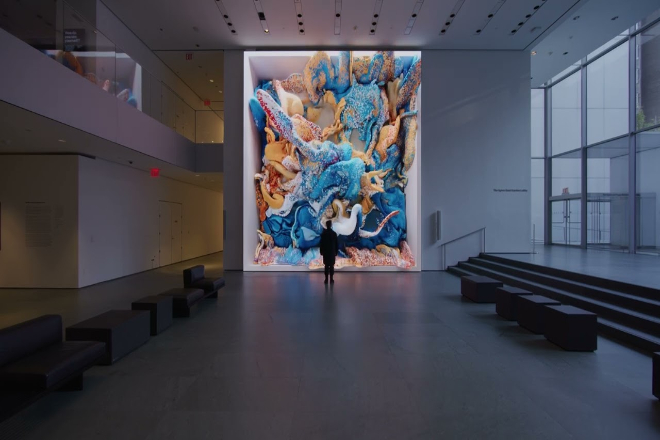
5). Art and technology cross-border
The display screen promotes cross-border cooperation between art and technology, and artists and technology teams jointly explore the application potential of new technologies in the field of art.
For example, artist Refik Anadol’s “Unsupervised” at MoMA uses artificial intelligence to process the metadata of museum collections and reconstruct the history of modern art.
This cross-border cooperation has brought new tricks to both artistic creation and audience experience.
This cross-border cooperation not only provides new possibilities for artistic creation but also brings a new artistic experience to the audience.
In these ways, the display screen “resurrects” the artwork and brings a more vivid, interesting and profound visual experience to the audience.
3. Which LED display screen is suitable for the exhibition?
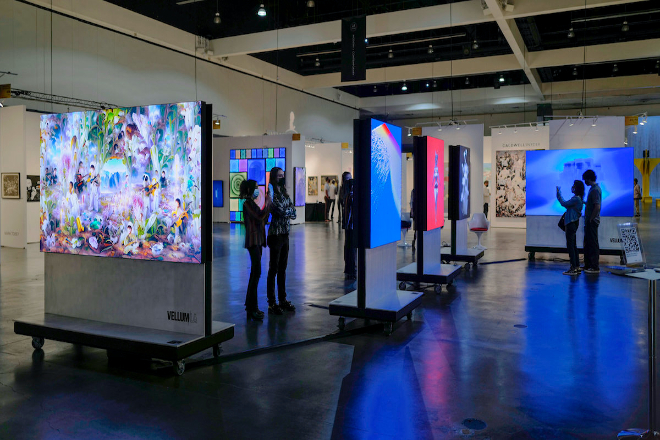
An indoor LED display screen is one of the most common choices in exhibitions. They usually have high 解決, rich colours, high pixel density, and can present delicate and clear pictures, which is very suitable for close viewing.
This kind of display screen has high colour reproduction and strong visual impact, and can perfectly display various exhibits or works of art with rich details.
Whether it is a product launch conference, a corporate showroom or an art exhibition, the indoor LED display screen can provide a high-quality visual experience and become an important tool to attract the audience’s attention.
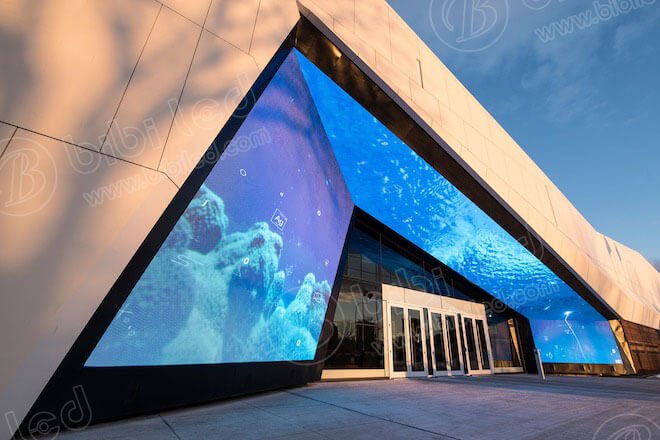
2). Outdoor LED display screen
An outdoor LED display screen is suitable for use in strong light environments. They are extremely bright and can ensure that they are still clearly visible under direct sunlight.
In addition, outdoor LED displays are also waterproof and dustproof, suitable for long-term exposure to outdoor environments.
This type of display is usually used in large outdoor exhibitions, auto shows, square activities and other scenes, which can attract the audience’s attention from a distance and display advertisements, product information or event content.
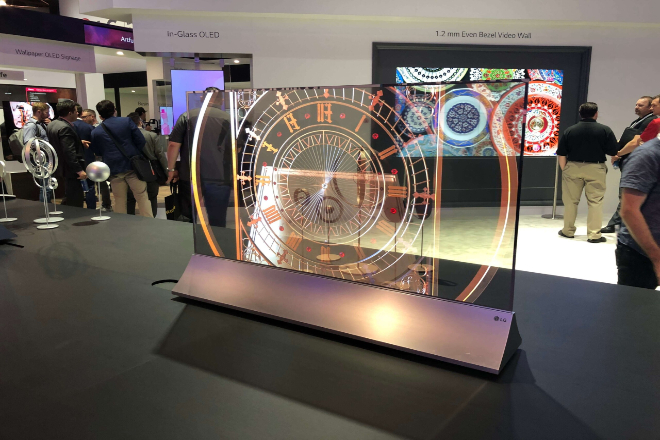
3). 透明なLED表示画面
A transparent LED display screen is a very creative display technology. It has very high transparency and can be integrated with the background to create a suspended and three-dimensional visual effect.
This display screen not only enhances the sense of space and technology, but also can display additional images or video content without blocking the original space.
Transparent LED display screens are particularly suitable for scenes such as shopping mall windows, glass curtain walls, art exhibitions, etc., which can add a unique visual charm to the exhibition.
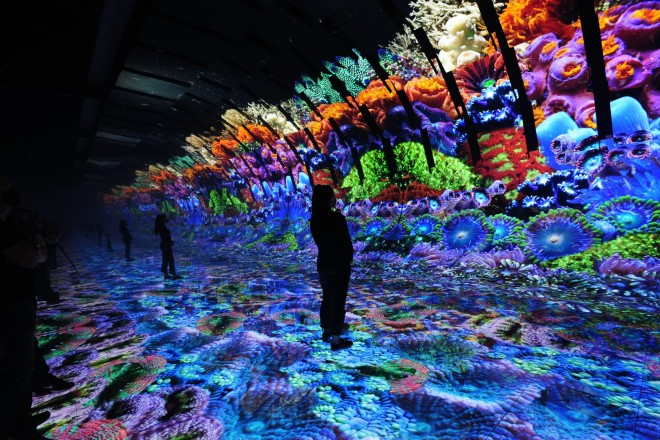
The emergence of flexible LED display screens has brought more creative possibilities for exhibition displays.
This display screen can be bent into various shapes, such as arcs, waves, etc., with diverse and dynamic shapes.
Flexible LED display screens can be customised according to the venue and display requirements to create unique visual effects.
It is particularly suitable for creative displays, personalised customisation, ステージ backgrounds, art installations and other scenes, which can attract the audience’s attention and leave a deep impression.
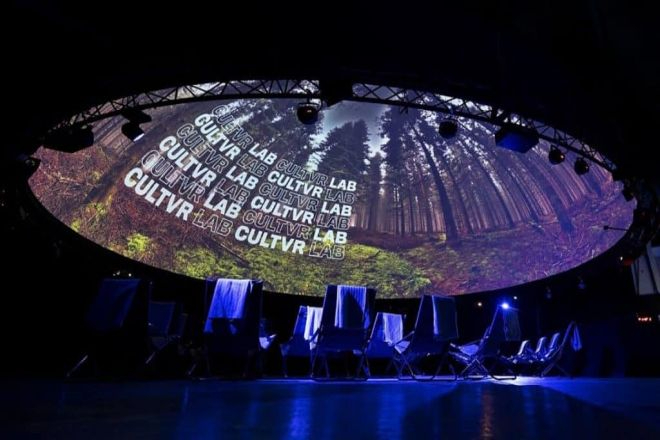
5). LEDレンタルスクリーン
For short-term exhibitions or events, LED rental screens are a very practical choice. This display screen is easy to disassemble and install, convenient to transport and install, and is very suitable for temporary display needs.
The LED rental screen has excellent picture quality and high resolution, can provide high-quality visual effects, and is also very cost-effective.
It is suitable for various short-term exhibitions, product launches, event opening ceremonies and other scenes, and can meet different display needs.
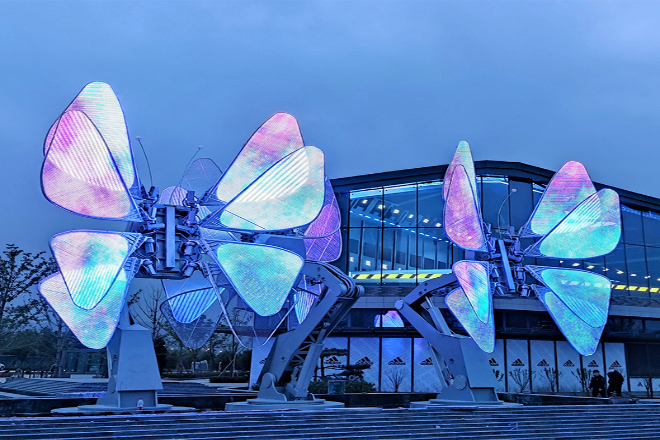
6). Special-shaped LED display screens
Special-shaped LED display screens can be customised in various unique shapes according to the venue and display requirements, such as spherical screens, wave screens, curved screens, etc.
This display screen has extremely high design flexibility and can bring extremely creative and visually attractive display effects to the exhibition.
Special-shaped LED display screens are particularly suitable for creative displays, art exhibitions, high-end exhibitions and other scenes.
They can become the focus of the exhibition site, attract the audience’s attention and enhance the display effect.
4. Examples of LED display screens in displaying different types of artworks
1). Nanjing Deji Art Museum “Jinling Map Digital Art Exhibition”
This Qing Dynasty “Jinling Map” was originally a static ancient painting, but through the high-definition LED display, all the details in the painting are magnified and clearly displayed in front of you.
Every stroke and every line can be seen clearly, and the colors are also particularly bright.
Moreover, this LED display screen can interact with the audience. When everyone wears the smart bracelet, they can “project” themselves into the painting.
It feels like traveling through time and space and walking directly into the Jinling City a thousand years ago.
The characters, buildings, and streets in the painting are all moving, as if they have come to life all of a sudden. This feeling is so shocking!
This is not only about looking at a painting, but more like walking into a living historical scene, which gives people a new feeling for ancient art and also brings a super cool new way to display traditional cultural relics.
2). Smithsonian Museum of Art and Industry “Futures” Exhibition
In the “Futures” exhibition of the Smithsonian Museum of Art and Industry in the United States, a 55-inch transparent OLED display screen is used to display a new form of futuristic communication.
The audience seemed to have walked into a time tunnel, and the content displayed on the display screen was perfectly integrated with the surrounding environment, creating a wonderful experience of combining virtuality and reality.
This transparent OLED display technology allows the audience to directly see the exhibits behind the screen, while also enjoying the dynamic images on the screen, as if the exhibits were “resurrected”.
3). MSG Sphere in Las Vegas, USA
Although not a traditional museum, the MSG Sphere in Las Vegas is an outstanding example of LED technology.
The venue’s spherical LED display is one of the largest of its kind in the world, with a resolution of 16K, providing a truly immersive experience.
Through this ultra-high-definition LED display, the audience can enjoy various art performances and exhibitions, as if they were in a virtual art world.
This immersive experience not only allows the audience to feel the charm of art, but also allows the artworks to be “resurrected” through modern technology and glow with new vitality.
5。結論
Through the magical charm of LED displays, artworks are no longer just static displays, but have become vivid, interesting and infectious experiences.
Whether it is an exhibition in a museum or a commercial exhibition, an LED display can make artworks shine with new brilliance, attract the audience’s attention and leave a deep impression.
最後に、LEDディスプレイについてもっと知りたい方は、 お問い合わせください.
あなたは興味があるかもしれません:
Other articles about exhibition LED display:

